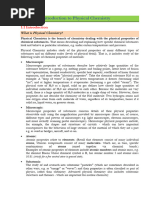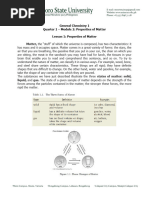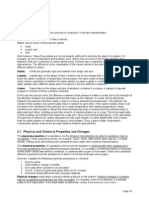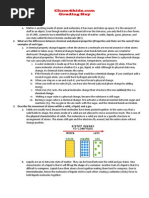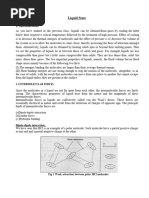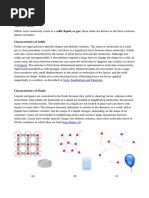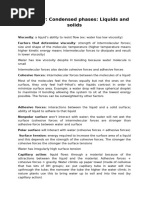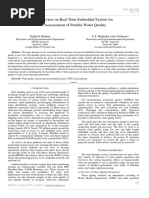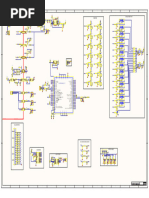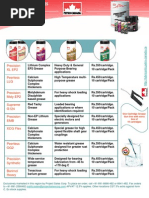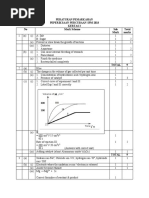The Particulate Nature of Matter: Explanation
The Particulate Nature of Matter: Explanation
Uploaded by
Shridhar MathadCopyright:
Available Formats
The Particulate Nature of Matter: Explanation
The Particulate Nature of Matter: Explanation
Uploaded by
Shridhar MathadOriginal Description:
Original Title
Copyright
Available Formats
Share this document
Did you find this document useful?
Is this content inappropriate?
Copyright:
Available Formats
The Particulate Nature of Matter: Explanation
The Particulate Nature of Matter: Explanation
Uploaded by
Shridhar MathadCopyright:
Available Formats
CHAPTER 1
THE PARTICULATE NATURE
OF MATTER
1. List the essential differences between a chemical and a physical change.
Indicate what type of changes take place in the following process and
explain clearly in each case:
Explanation:
During a physical change, the physical property of matter, such as temperature, pressure, density, mass, volume, color, boiling point, melting point,
energy content, etc., has changed BUT the chemical property of the matter
stays intact. Such physical change is reversible by changing the physical
conditions, such as temperature and pressure, back to their original states.
During a chemical change, the chemical property of matter has changed.
This change results in the formation of new substances which have different
chemical compositions from the starting substance. Such chemical change is
usually irreversible by any simple change of the physical conditions.
What is a chemical property?
A: The chemical property of a matter is actually its unique chemical potential
in reacting with other matter. For example, when sodium reacts with chlorine to form sodium chloride, sodium atom loses an electron while chlorine
atom gains an electron. The potential of the sodium atom to lose an electron
in the presence of the chlorine atom is the chemical property for the sodium,
while the potential to gain an electron for the chlorine atom in the presence
of the sodium atom is the chemical property for chlorine.
1
Understanding Basic Chemistry Through Problem Solving
So, does that mean that chlorine atom would forever have the same
potential to gain electrons irrespective of the type of substances that
it reacts with?
A: No! When a chlorine atom reacts with a hydrogen atom, the chlorine atom does
not gain an electron. In fact, the chlorine atom shares electrons with the hydrogen atom. In essence, the chemical property of a matter can vary, depending on
the chemical property of the other matter that it is reacting with. You can refer
to Understanding Basic Chemistry by K.S. Chan and J. Tan for more details.
Do you know?
Matter is made up of very small particles, such as an atom, ion, or molecule, being attracted to one another by electrostatic forces of attraction. The different strengths of the attractive forces between these small
particles result in the different physical states of matter.
There are three states of matter: solid, liquid, and gas. The strength of
the attractive force between the particles would give rise to the physical
state of the matter.
If the strength of attraction is very strong, we have solid matter, which
results in its fixed shape and fixed volume. A weaker strength of attraction gives us liquid, which has a fixed volume but no fixed shape. The
strength of attraction is the weakest in a gas, causing it to have neither
a fixed shape nor a fixed volume.
The force that causes the small particles to be attracted together is
known as electrostatic force. It is just a type of electrical force
between particles that possess opposite electrical charges. This electrostatic force is the chemical bond that holds the particles together.
(Continued )
The Particulate Nature of Matter
(Continued )
Thus, if the chemical bond is of different strengths, it will result in different types of arrangement of particles in the physical state, which
would therefore decide whether the matter has fixed shape or fixed volume. And because of the different types of arrangement, the particles
have different types of motion in the physical state and also different
levels of compressibility. Furthermore, the reason for different amounts
of energy being involved in the chemical reaction is due to the reaction
of different types of matter possessing different chemical bond strengths.
In the solid state, the particles can only vibrate about a fixed position.
But in the liquid and gaseous states, the particles have translational
motion; it is free to move randomly in all directions.
Why is the compressibility of the solid and liquid so much lower than
that for the gas?
A: Since the gas particles are far apart, when we compress a gas by exerting
a pressure, the distance of separation between the gas particles can be decreased. If the pressure is high enough, the gas would be converted to the
liquid state in which the particles are closer to each other. This is what happens during the liquefaction of gas by the application of pressure. Further
compression would then be difcult to make the particles in the liquid state
to come even closer together as there would be too much repulsive forces
acting between the particles. We could expect more difculty in compressing a solid than a liquid.
So, it is actually the weak attractive forces between the particles in
the gaseous state that help to pull the particles even closer together
during compression?
A: You are right! A lot of students think that it is the applied pressure ALONE
that helps to push the particles together; this is INCORRECT. Without the
attractive forces acting between the particles in the gaseous state, the particles would not be held on together in the liquid state. This also explains
why a gas with extremely weak attractive forces is difcult to be liqueed
through the using of high pressure alone.
Understanding Basic Chemistry Through Problem Solving
(a) Addition of potassium to water.
Explanation:
Potassium reacts with water to give potassium hydroxide and hydrogen as
follows:
2K(s) + 2H2O(l) 2KOH(aq) + H2(g).
Since the new products, KOH and H2, have different chemical properties
from the reactants, the above change is a chemical change. In addition,
since the reactants cannot be formed back from the products simply by the
change of the reaction conditions, such as temperature and pressure, the
reaction is an irreversible one.
Do you know?
Potassium is a metal and the fact that hydrogen gas is formed when
potassium reacts with water, indicates that water is acting as an acid.
An acid is characterized by any one of the following three possible
reactions:
An acid reacts with a metal to give hydrogen gas.
An acid reacts with a carbonate/hydrogencarbonate to give carbon
dioxide gas.
An acid reacts with a base to give salt and water.
(b) Salt dissolves in water.
Explanation:
Salt dissolves in water to give a salt solution. There is no change in the
chemical composition of the salt and the water. When heat is applied to
the salt solution to drive away the water, the original salt can be recovered.
Thus, the dissolving of the salt in water is just a physical change.
The Particulate Nature of Matter
But when the salt is dissolved, it disappears. So, shouldnt the change
be a chemical one?
A: In a chemical change, the chemical property of the substance will change.
Solid salt, such NaCl, consists of sodium (Na+) and chloride (Cl) ions being attracted to each other. When the salt dissolves, there is no change in the
chemical composition except that the ions are simply separated by the water
molecules. That is, the Na+ and Cl ions of the salt are not transformed into
any other species that are different from themselves. During evaporation,
the water molecules that are between the ions are removed and this process
causes the ions to be closer to each other once again. Hence, the dissolution
of salt is a physical change!
Do you know?
The salt that dissolves in water is known as the solute, while the water
is known as the solvent.
The salt solution is homogeneous in nature as you cannot differentiate
the salt from the water and the solution does not resemble the solid salt
at all. Thus, these may mean that the salt solution is a compound. But
we are able dissolve as much salt as possible until it does not dissolve
any more. This would mean that the composition of the salt solution is
variable. From this, we can conclude that the salt solution is a mixture.
In addition, when the solution is evaporated to dryness, we get back the
same old solid salt. Therefore, all these phenomena mean that the dissolution of salt involves physical changes and not a chemical one!
A mixture is a substance that contains two or more substances which are
physically together but have not chemically reacted with one another.
A mixture can be a mixing of more than two elements, a mixing of
more than two compounds, or a mixing of elements and compounds.
A compound is a pure substance, containing two or more elements,
chemically combined together.
An element is defined as a substance which cannot, by known chemical
means, be split up into two or more simpler substances.
(c) Burning a piece of paper in air.
Understanding Basic Chemistry Through Problem Solving
Explanation:
Burning a piece of paper in air will result in the formation of carbon dioxide gas and water vapor. Since the new products, CO2 and H2O, which
have chemical properties different from the reactants, the above change is
a chemical change. In addition, since the reactants cannot be formed back
simply by the change of the reaction conditions, such as temperature and
pressure, the reaction is an irreversible one.
(d) Heating of ammonium chloride.
Explanation:
When ammonium chloride is heated, it decomposes to form the ammonia
and hydrogen chloride gases:
NH4Cl(s) NH3(g) + HCl(g).
Since the new products, NH3 and HCl, which have chemical properties
different from the reactants, the above change is a chemical change.
But NH3 and HCl can easily form back to the solid NH4Cl upon
cooling. So, shouldnt the above change be a physical change
instead?
A: You are right that the decomposition of NH4Cl is a reversible one. But because NH3 and HCl are chemically different from NH4Cl, the above change
cannot be classied as a physical change. So, from this example, it is important to note that the important criteria to classify a change as a chemical one
is whether new compounds of different chemical properties are formed. The
reversibility of the change is a secondary criteria.
The Particulate Nature of Matter
Do you know?
The formation of NH4Cl from NH3(g) and HCl(g) through diffusion is
a very good experiment to support the theory that matter is made up of
small particles, such as atom, ion or molecule.
Diffusion refers to the process that explains the movement of
particles from a region of high concentration to one of a lower
concentration.
The fact that particles of one matter can diffuse through another matter,
i.e., the NH3(g) and HCl(g) particles moving through the air particles,
is hard evidence that there are gaps between particles in a matter. Thus,
the bigger the gap between the particles, the greater the rate of diffusion. We would expect diffusion to be slow in solid, faster in liquid, and
fastest in gas. In a nutshell, diffusion through higher-density matter is
slower than through lower-density matter.
Diffusion is dependent on the concentration gradient, i.e., the higher the
concentration of the particles, the greater the rate of diffusion.
Another factor that affects diffusion is temperature. The higher the
temperature means that the particles have higher kinetic energies,
resulting in a higher rate of diffusion.
Another obvious variable is the mass of the particle. The larger the
mass, the slower the movement of the particle, hence the lower the rate
of diffusion. Thus, we would expect a denser gas, which has a higher
density because of a greater particulate mass, to diffuse slower than a
gas with lighter density. Therefore, the fact that the white solid ring is
formed closer to the HCl is an evident that a HCl particle is heavier in
mass than a NH3 particle.
Understanding Basic Chemistry Through Problem Solving
But doesnt a greater mass certainly mean higher K.E. since
K.E. = 12 mv 2?
A: There is a fallacy here. If two particles of different masses have the same
speed, then the one that has a greater mass would have a greater K.E. But if
these two particles of different masses have the same K.E., then it can only
mean that the one that has a greater mass must have a lower speed.
(e) Addition of water to lime juice.
Explanation:
Addition of water to lime juice does not cause the formation of new
matter. Hence, the change is a physical change. In fact, this is simply a
dilution process.
Do you know?
When you add more solvent to a solution, the amount of solute does not
change BUT the volume of the solution increases. So, we say that the
amount of solute is conserved!
Since concentration is either defined as the molar concentration
(mol dm3) or mass concentration (g dm3), after dilution, the concentration of the solution decreases because ONLY the volume of the solution is changed and not the amount of substances that is dissolved in the
solution.
The Particulate Nature of Matter
2. The melting and boiling points of six substances are given in the
following table.
Substance
Melting point/C
Boiling point/C
A
B
C
D
E
F
97
44
40
116
834
189
891
282
359
184
1432
185
(a) Which substances are liquids at room temperature?
Explanation:
Room temperature is about 25C. In order for a substance to remain as a
liquid at a particular temperature, the boiling point of the substance must
be above this particular temperature. Similarly, in order for the substance
to be a liquid, it must have a melting point that is below this particular
temperature. In this case here, we must look for substances with boiling
points that are above 25C and melting points that are below 25C. Hence,
substances C and E are liquids at room temperature.
In actuality, why cant a substance remain as a solid at 25C if its
melting point is below 25C?
A: When a temperature is above the melting point or the boiling point of a
substance, this means that the substance can absorb heat energy from the
surroundings and undergo phase transition or change of state. But if the surrounding temperature is lower than the melting or boiling point of the substance, there is not enough supply of heat energy from the surroundings to
help the substance undergo phase transition. Take for instance, a piece of
ice at 0C is left in the open with a temperature of 25C; there is more than
enough heat energy in the surroundings for the ice to absorb and then melt.
But if this piece of ice is placed in a condition of 0C, the piece of ice would
not melt completely as it cannot extract any heat from the surroundings.
10
Understanding Basic Chemistry Through Problem Solving
Wait a minute, you said that at 0C, a piece of ice cannot melt completely. Does that mean that both ice and liquid water coexist at 0C?
A: Yes! In fact, at the melting or boiling points of a substance, both physical
states of the substance coexist. A lot of students assume that at 0C, you
only have solid ice, as 0C is the freezing point of ice. But 0C is also the
melting point of ice, so you would have the coexistence of both physical
states. We say that the system is at dynamic equilibrium during the phase
transition:
What is dynamic equilibrium?
A: The term dynamic means change. But you would not be able to see the net
change because both the rates of freezing and melting are the same. Hence,
you would not be able to observe ice continue to form from the freezing of
water and neither would you see water continue to form from the melting of
ice. At such a state, the system is said to be at equilibrium as there is no
net change being observed.
(b) Which substance will change its physical state when heated from 0C
to 54C?
The Particulate Nature of Matter
11
Explanation:
In order for a substance to change its physical state during heating, the
starting temperature must be either below its melting point or boiling
point or both. Since 0C is below the melting point of substances A, B,
and D, while 54C is above the melting point of substance B, this means
that only substance B would undergo a change of state when it is heated
from 0C to 54C.
Do you know?
The energy content of a solid is lower than that of the liquid, while the
liquid is lower than that of a gas:
When a solid undergoes melting, the absorbed energy is used to help
weaken the bond between the particles in the solid state. As energy cannot be created nor destroyed based on the Law of Conservation of
Energy, the energy that is absorbed during melting is transferred as
the energy content of the liquid. This thus makes the liquid possess a
higher energy content than the solid. Similarly, when the liquid is converted to the gaseous state, the energy content of the gas is higher than
that of the liquid.
12
Understanding Basic Chemistry Through Problem Solving
But since energy is absorbed during a melting process, why is the
measured temperature a constant value during this process?
A: The following is a heat curve that shows the corresponding changes in
temperature versus the energy absorbed (in calories) as water undergoes
the phase transition between the liquid and gaseous states.
From 0C to 100C, the energy that the system has absorbed increases the
temperature of the water because the energy that is absorbed is converted
into the kinetic energy of the particles. With a higher kinetic energy, the
particles move very rapidly. Due to the rapid movement, the particles cannot attract each other strongly as the distance of separation between the
particles increases. At the 100C point, the kinetic energy of the particles is
sufcient to help the particles overcome the attractive forces from the other
particles. Hence, the particles can escape into the gaseous phase. As a result,
the energy that is introduced into the liquid will not go into increasing the
temperature anymore (as the kinetic energy of the particles of liquid water
no longer increases); it will be used to just send the particles of the liquid
water into the gaseous state. So, imagine when the particles escape into the
gaseous phase, the energy from the ame cannot be imparted onto it, so
how can we have an increase in kinetic energy and in turn, an increase in
temperature? Therefore, no matter how high the temperature of the ame is,
a pot of boiling water will remain at 100C until all of the liquid water has
been converted to the gaseous phase. Then, further heating of the gaseous
water particles without any liquid water present would then increase the
kinetic energy of the gaseous particles, hence the temperature of the gas.
The Particulate Nature of Matter
13
So, does it mean that when the liquid solidies, the same amount of
energy that is absorbed during melting is given off?
A: Absolutely spot on! This is based on the Law of Conservation of Energy.
(c) Which substance exists in the liquid state over the smallest range of
temperature?
Explanation:
In order to exist as a liquid, the temperature must be below the boiling
point and above the melting point. Thus, to determine the range that the
substance would exist as a liquid, we need to calculate the temperature
range that is in between the melting and boiling points:
Substance
Melting
point /C
Boiling
point /C
Difference between boiling point
and melting point/C
A
B
C
D
E
F
97
44
40
116
834
189
891
282
359
184
1432
185
891 97 = 794
282 44 = 238
359 (40) = 399
184 116 = 68
1432 (834) = 2266
185 (189) = 4
The substance that exists as a liquid with the smallest range of temperature is F.
3. Use the Kinetic Particle Theory to explain each of the following:
(a) The volume occupied by 18 g of liquid water is 18 cm3, but 1 g
of water vapor occupies a volume of about 24,000 cm3 at room
temperature and pressure.
14
Understanding Basic Chemistry Through Problem Solving
Explanation:
Both liquid water and water vapor consists of small particles in constant
random motion. The volume of 1 g of water vapor is so much larger than
the volume occupied by 18 g of water because the distance of separation
between the particles in the vapor state is much larger than that in the
liquid water.
Why is the separation between the particles so much larger in the
vapor state than in the liquid state?
A: The larger separation between the particles is brought about by the weaker
electrostatic attractive force between the particles in the vapor state than
in the liquid state. In a gas, the separation between particles is very large
compared to their particulate sizes, such that there are virtually no attractive or repulsive forces between the particles, except during collisional
contact. In a liquid, the particles are still far apart, but now they are close
enough such that attractive forces conne the matter to the shape of the
container that it occupies. In a solid, the particles are so close together that
the forces of attraction conne the matter to a specic shape with a distinct
boundary.
So, the distance of separation between the particles is a consequence
of the strength of the electrostatic attractive force and not the other
way round?
A: It depends! If you have a solid, a liquid, and a gas, then based on their
physical states which already are xed, then you can say that the distance
of separation between the particles is a consequence of the strength of the
electrostatic attractive force. But if you are melting a solid or boiling a liquid, then when the particles absorb energy which results in an increase in
the kinetic energy, the higher kinetic energy would cause the particles to
move faster, hence increasing the distance of separation. This increase in the
distance of separation then causes the weakening of the electrostatic force
of attraction between the particles.
The Particulate Nature of Matter
15
I see, so the difference in applying the concept depends on whether we
are talking about the product or the process?
A: Yes! In the product (a solid, a liquid, or a gas), the distance of separation is
already a consequence. But in the process, melting or boiling, the distance
of separation is not a xed consequence, but rather, it is a change because
of the continual absorption of energy. This change would then lead to the
consequence, i.e., a weaker attractive force.
Do you know?
There were a few simple assumptions that were made when deriving the
Kinetic Theory of Matter:
Matter consists of a large number of small particles, which can be
atoms, ions, or molecules.
There is a large separation between these particles, be it in the solid,
liquid, or gaseous state. As such, the size of the particle is negligible
as compared to the distance of separation between the particles.
Hence, the particles can be considered as point mass.
The particles are in constant motion.
As a consequence of constant motion, the particles possess kinetic
energy, which is the energy of motion. The faster the speed of the
particle, the higher the kinetic energy.
The kinetic energy is transferred between the particles during their
collisions or onto the wall of the container. There is no loss in the total
energy of the system in accordance to the Law of Conservation of Energy.
The higher the temperature of the matter, the higher the kinetic
energy of the particles in the matter.
The collision on the wall of container gives rise to the concept of
pressure.
In a nutshell, the Kinetic Theory Model assumes that matter is made up
of a large number of particles, widely separated, and in constant
motion, thus possessing kinetic energy which is transferred during collision. This model is very useful to help us understand how two or more
types of matter react to give another substance. Basically, in a chemical
reaction, different particles from different types of matter must collide
with each other when they react and in this process, energy transfer
takes place causing chemical bonds to break and form.
16
Understanding Basic Chemistry Through Problem Solving
(b) Water vapor at 100C can burn our skin more badly than boiling water.
Explanation:
Water vapor at 100C can burn our skin more badly than boiling water
because the water molecules in water vapor carry more kinetic energy
than those in boiling water. As a result of the greater amount of kinetic
energy, when the gaseous water molecules hit the skin, more heat energy
is transferred to the skin, causing the skin to burn more badly.
Is the average kinetic energy directly proportional to temperature
(K.E.ave T )? If so, then shouldnt water vapor at 100C and boiling
water have about the same amount of kinetic energy?
A: Yes, average kinetic energy is in fact directly proportional to temperature.
But this does not mean that water vapor at 100C has the same amount of
energy as that of the boiling water. Why? This is because before the water
molecules in boiling water is converted to water vapor, there is an additional
amount of energy needed. This energy is known as the latent heat of vaporization, which does not lead to an increase in the temperature of the water
vapor nor the boiling water. As a result, the water molecules in water vapor
actually carry more energy than those in boiling water.
(c) Water boils at a lower temperature high up in a mountain than it does
at sea level.
Explanation:
When water molecules gain more kinetic energy during heating, more
water molecules can evaporate off from the surface. But soon, these gaseous water molecules can be knocked back into the liquid water by air
molecules. As the temperature reaches the boiling point, more water molecules evaporate. As a result, the number of water molecules that are being
knocked back is relatively smaller than those that have evaporated.
The Particulate Nature of Matter
17
Hence, you have boiling taking place. Up in a mountain, the pressure is
lower, meaning there are fewer air particles. As a result, we do not need a
higher temperature to create a substantial amount of water molecules to
push against the lower atmospheric pressure. Thus, the boiling point is
lower.
Do you know?
Pressure is the collisional force exerted onto the wall of the container.
Mathematically, Pressure = Force
, whereas Force = mass acceleration
Area
(F = m a). The amount of collisional force acting on the wall depends
on the number of gas particles in the system, the volume of the system,
the mass of the gas particle, and the speed of the gas particle.
More gas particles (n) at the same volume and temperature as compared
to another which contains fewer gas particles, would mean that there is
greater collisional frequency. Hence, there is higher pressure ( p n)!
For the same amount of gas particles, a smaller volume (V ) at the same
temperature as compared to another one of larger volume, would also
mean that there is greater collisional frequency as the particles have less
space to move before knocking onto the wall of container again. Hence,
there is higher pressure (p 1/V )!
For the same amount of gas particles, a higher temperature (T ) with the
same volume as compared to another one of lower temperature would
mean that there is greater collisional frequency as the particles have more
kinetic energy and the particles move very fast. Therefore, the duration
between two collisions is shorter, resulting in higher pressure ( p T )!
18
Understanding Basic Chemistry Through Problem Solving
Why do we need a pressure cooker to cook at a higher altitude? How
does a pressure cooker work?
A: As the boiling point of water is low at high altitude, this would mean that
a smaller amount of heat is needed for the water to reach the lower boiling
point. This lower heat content is not sufcient to cook the food. In a pressure
cooker, the steam that is formed is not allowed to escape as it is sealed. As a
result, pressure would slowly build up in the cooker. This built-up pressure
would in turn increase the boiling point of water, hence allowing the water
to take in more heat energy before it boils. With more heat content, the food
can be cooked!
How does a pressure cooker shorten the cooking time of food?
A: The boiling point of water can be increased far beyond the 100C at normal
atmospheric pressure. As a result, more heat energy can be transferred into
the system without losing this heat energy to vaporize the liquid water. At
a higher temperature, the rate of cooking is greater, thus a shorter time is
needed.
4. A 100-cm-long tube was clamped horizontally as shown on p. 7.
A piece of cotton wool soaked with concentrated sulfur dioxide solution was placed at one end of the tube, while another piece of cotton
wool soaked in concentrated hydrogen sulde solution was placed at
the other end. The relative molecular masses of hydrogen sulde and
sulfur dioxide are 34 and 64, respectively.
After several minutes, a ring of pale yellow solid was formed inside
the tube. The word equation for the reaction is
hydrogen sulde + sulfur dioxide sulfur + water.
(a) Identify the pale yellow solid formed in the tube.
Explanation:
The pale yellow solid is sulfur.
The Particulate Nature of Matter
19
(b) Did the yellow solid form closer to hydrogen sulde or sulfur dioxide? Explain your answer based on the Kinetic Theory.
Explanation:
Since the rate of diffusion decreases with an increase in the mass of the
particle, we would expect sulfur dioxide (relative molecular mass of 64)
to move slower than hydrogen sulfide. As a result, the sulfur solid would
be formed closer to the sulfur dioxide.
But doesnt a higher mass certainly mean higher K.E. since
K.E. = 12 mv 2?
A: There is a fallacy here. If two particles of different masses have the same
speed, then the one that has a greater mass would have a greater K.E. But if
these two particles of different masses have the same K.E., then it can only
mean that the one that has a greater mass must have a lower speed. Now,
since the temperatures of the two gases are the same, this would mean that
the average kinetic energies of the two gases must be the same. Hence, the
heavier sulfur dioxide would have a lower speed than the lighter hydrogen
sulde.
You might also like
- Advances in Silicon Science 4Document398 pagesAdvances in Silicon Science 4Rodolfo Angulo OlaisNo ratings yet
- SCI NOTESDocument3 pagesSCI NOTESKaye Marie PepitoNo ratings yet
- Syllabus of Instruction: 'Prelim' Matter Kinds and Forms Chemical Nature of Matter Physical Nature of MatterDocument20 pagesSyllabus of Instruction: 'Prelim' Matter Kinds and Forms Chemical Nature of Matter Physical Nature of MatterAndy AlmineNo ratings yet
- ااااااافDocument134 pagesااااااافndeemoo10No ratings yet
- Ati Teas 7 Chemistry ReviewDocument26 pagesAti Teas 7 Chemistry ReviewSAMUEL WAMNo ratings yet
- AP Chemistry Notes Chapter 10 - Liquids, Solids, and Intermolecular ForcesDocument6 pagesAP Chemistry Notes Chapter 10 - Liquids, Solids, and Intermolecular ForcesHui HeNo ratings yet
- Reviwer 3RD QuarterDocument19 pagesReviwer 3RD QuartermoraledazoesophiaNo ratings yet
- G8 REVIEWERDocument5 pagesG8 REVIEWERMARASIGAN, Meldy AndalNo ratings yet
- 60b24f93-1d95-411c-8a95-e3c5aa6d2d1f-S5 Chemistry Notes-Ndejje Senior Secondary School Introduction to Physical Chemistry 2020Document60 pages60b24f93-1d95-411c-8a95-e3c5aa6d2d1f-S5 Chemistry Notes-Ndejje Senior Secondary School Introduction to Physical Chemistry 2020okidiagaraNo ratings yet
- General Chem 1-Lecture 1Document9 pagesGeneral Chem 1-Lecture 1Arcely LopezNo ratings yet
- States of MatterDocument17 pagesStates of MatterThaarvena RetinaNo ratings yet
- Phases of Matter SimDocument25 pagesPhases of Matter SimJohn Van Dave TaturoNo ratings yet
- Everything MattersDocument6 pagesEverything MattersArtemis RionessiNo ratings yet
- Notes of Sicence, ElementsDocument25 pagesNotes of Sicence, Elementsvickykaur60No ratings yet
- General Chemistry MODULE 2Document8 pagesGeneral Chemistry MODULE 2Buelah Ivy MendozaNo ratings yet
- Mod 1 - Properties and Structure of Matter NotesDocument114 pagesMod 1 - Properties and Structure of Matter NotesRadhika BakshiNo ratings yet
- Lesson 1:the Kinetic Molecular TheoryDocument36 pagesLesson 1:the Kinetic Molecular TheoryKarylle MorlaNo ratings yet
- 2 Matter: Solids: Liquids: Liquids Take On The Shape of Their Container But Do Not Change Their Volume. For ExampleDocument5 pages2 Matter: Solids: Liquids: Liquids Take On The Shape of Their Container But Do Not Change Their Volume. For ExampleRegz GasparNo ratings yet
- GEN-CHEM-2-MODULE-1-1Document21 pagesGEN-CHEM-2-MODULE-1-1set.ronquilloNo ratings yet
- Phases of Matter SimDocument32 pagesPhases of Matter SimMiguela Ecle Gonzales91% (23)
- CHM 204 NOTEDocument15 pagesCHM 204 NOTEfatimaia3565No ratings yet
- 电化学专业英语Document115 pages电化学专业英语Bruce LiNo ratings yet
- Model of Matter SCIENCE DetailllDocument3 pagesModel of Matter SCIENCE Detailllzulabedin475No ratings yet
- Biological Molecules NotesDocument10 pagesBiological Molecules NotesSamantha SinghNo ratings yet
- Matter: Inorganic Chemistry Group 1Document22 pagesMatter: Inorganic Chemistry Group 1Fer-J TagacayNo ratings yet
- Oral Presentation PPDocument71 pagesOral Presentation PPSaubie AslamiahNo ratings yet
- GENCHEM1MOD1Document29 pagesGENCHEM1MOD1Renzsoc JalmascoNo ratings yet
- The Nature of MatterDocument26 pagesThe Nature of MatterEsma KurtanovićNo ratings yet
- MatterDocument19 pagesMattersandeepNo ratings yet
- Gen Chem q1 w1 2Document7 pagesGen Chem q1 w1 2ARIEL ANGELIONo ratings yet
- CH 10Document39 pagesCH 10Chala1989No ratings yet
- Classification of MatterDocument4 pagesClassification of MatterDum Spiro SperoNo ratings yet
- Properties of ElementsDocument4 pagesProperties of ElementsDaniel HodgesNo ratings yet
- Thermal physics. NSpdfDocument5 pagesThermal physics. NSpdfren71602No ratings yet
- Animated Chemistry LessonDocument11 pagesAnimated Chemistry Lessonoscaroriginal2007No ratings yet
- Quimica Universidad PRINCIPIANTES TraducidaDocument5 pagesQuimica Universidad PRINCIPIANTES TraducidaAUSTRANo ratings yet
- Siagan, Karl Gerard M. (Activity #1 IMF's)Document5 pagesSiagan, Karl Gerard M. (Activity #1 IMF's)Karl SiaganNo ratings yet
- MODULE 1 Gen Chem 1 1 PDFDocument9 pagesMODULE 1 Gen Chem 1 1 PDFJam Aica100% (1)
- The Four Intermolecular Forces and How They Affect Boiling PointsDocument56 pagesThe Four Intermolecular Forces and How They Affect Boiling PointsUng Hie HuongNo ratings yet
- Is Matter Around Us PureDocument14 pagesIs Matter Around Us Purepunksnotdead_t7100% (1)
- C1-States of MatterDocument116 pagesC1-States of MatterGivemore MuromboNo ratings yet
- Chapter02 PDFDocument24 pagesChapter02 PDFSSBNo ratings yet
- Aggregate States of Matter - Nita VasadzeDocument6 pagesAggregate States of Matter - Nita VasadzeNita VasadzeNo ratings yet
- Materi Dan PerubahannyaDocument11 pagesMateri Dan PerubahannyaAniz DmurryNo ratings yet
- Nature of MatterDocument7 pagesNature of Matterahijoo14No ratings yet
- Chapter 1-Nature of matterDocument6 pagesChapter 1-Nature of matterizuchukwuikeleNo ratings yet
- Chemical Earth: 1. The Living and Non-Living Components of The Earth Contain MixturesDocument7 pagesChemical Earth: 1. The Living and Non-Living Components of The Earth Contain Mixturesfocuc98No ratings yet
- Matter, Properties, & Phases: by Emmanuel DikolelayDocument33 pagesMatter, Properties, & Phases: by Emmanuel DikolelayMaPhi ZaBeNo ratings yet
- Liquid StateDocument5 pagesLiquid Statejoevensonsiangshai01No ratings yet
- State of Matter: The Four Fundamental StatesDocument5 pagesState of Matter: The Four Fundamental StatesMai AbdelgelilNo ratings yet
- atomicDocument5 pagesatomicsiddiquigujjar551No ratings yet
- Fluid Mechanics 1Document7 pagesFluid Mechanics 1jimmymungai018No ratings yet
- CH 1 Matter in Our Surroundings 3Document58 pagesCH 1 Matter in Our Surroundings 3SHIVAKUMAR H PNo ratings yet
- Liquids and solidsDocument4 pagesLiquids and solidsthu.p.h.tranNo ratings yet
- 09 Science Notes Ch01 Matter in Our SurroundingsDocument9 pages09 Science Notes Ch01 Matter in Our SurroundingsAmbika RamakrishnanNo ratings yet
- Imelda B. Corpuz, RPH, MSPHDocument49 pagesImelda B. Corpuz, RPH, MSPHAdzrina AhmadNo ratings yet
- paper 1Document4 pagespaper 1lwali20092anjaliNo ratings yet
- 0 Chemical BondingDocument8 pages0 Chemical BondingRajasthancplAncplNo ratings yet
- Children Encyclopedia Chemistry: The World of KnowledgeFrom EverandChildren Encyclopedia Chemistry: The World of KnowledgeRating: 5 out of 5 stars5/5 (3)
- The Phases of Matter - Chemistry Book Grade 1 | Children's Chemistry BooksFrom EverandThe Phases of Matter - Chemistry Book Grade 1 | Children's Chemistry BooksNo ratings yet
- Combining Chemicals - Fun Chemistry Book for 4th Graders | Children's Chemistry BooksFrom EverandCombining Chemicals - Fun Chemistry Book for 4th Graders | Children's Chemistry BooksNo ratings yet
- List of PublicationsDocument2 pagesList of PublicationsShridhar MathadNo ratings yet
- Synthesis of Cobalt Nano Crystals in Aqueous Media and Its CharacterizationDocument6 pagesSynthesis of Cobalt Nano Crystals in Aqueous Media and Its CharacterizationShridhar MathadNo ratings yet
- XRD Impo2 PDFDocument6 pagesXRD Impo2 PDFShridhar MathadNo ratings yet
- NanoDocument88 pagesNanoShridhar MathadNo ratings yet
- 6093-Vol3 Chap01 v3Document44 pages6093-Vol3 Chap01 v3Shridhar MathadNo ratings yet
- The Influence of Calcium Doping On Structural and Electrical Properties of Ferroelectric Lead Titanate CeramicDocument5 pagesThe Influence of Calcium Doping On Structural and Electrical Properties of Ferroelectric Lead Titanate CeramicShridhar MathadNo ratings yet
- May 17, 2012 13:19 9in X 6in Everyday Probability and Statistics: b1373-ch00Document14 pagesMay 17, 2012 13:19 9in X 6in Everyday Probability and Statistics: b1373-ch00Shridhar MathadNo ratings yet
- A Review On Real Time Embedded System For Asscessment of Potable Water QualityDocument4 pagesA Review On Real Time Embedded System For Asscessment of Potable Water QualityEditor IJRITCCNo ratings yet
- ReporteDocument23 pagesReporteevizcardo4617No ratings yet
- Introduction To Electronics: Laboratory ManualDocument42 pagesIntroduction To Electronics: Laboratory ManualMikeNo ratings yet
- 18 Electrochemistry Redox Reactions and Voltaic Cells Bacalso Group 3 Rep 2 1Document6 pages18 Electrochemistry Redox Reactions and Voltaic Cells Bacalso Group 3 Rep 2 1Eepink ArchNo ratings yet
- BMS 48V 14S EPBamDocument1 pageBMS 48V 14S EPBamakhil mohanNo ratings yet
- Protein Binding of DrugDocument22 pagesProtein Binding of DrugManikanta GupthaNo ratings yet
- Problem Set 3Document2 pagesProblem Set 3HUANG ShashaNo ratings yet
- EE669 Lecture Slides Module 1Document46 pagesEE669 Lecture Slides Module 1sivanaresh14No ratings yet
- Conc Notes S05Document163 pagesConc Notes S05Susána SgfNo ratings yet
- Back bondingDocument5 pagesBack bondingappu78No ratings yet
- Teachers Guidebook CCE Whole GuideDocument375 pagesTeachers Guidebook CCE Whole GuideJedy Tah0% (1)
- Comprehensive Review On Homeopathic Uses of Acid: BenzoicumDocument3 pagesComprehensive Review On Homeopathic Uses of Acid: BenzoicumDipankar GangulyNo ratings yet
- Magnetic Water ConditionerDocument3 pagesMagnetic Water ConditionerSSNo ratings yet
- Thermal Degradation of Epoxy ResinsDocument29 pagesThermal Degradation of Epoxy ResinsRahul GogiaNo ratings yet
- TB Diode 3211430Document27 pagesTB Diode 3211430adamnorazlanNo ratings yet
- Mineral PropertiesDocument23 pagesMineral PropertiesSher AhmadNo ratings yet
- Siphon Purge SystemDocument29 pagesSiphon Purge SystemMuhammad SaadullahNo ratings yet
- Fire Detection and Alarm SystemsDocument15 pagesFire Detection and Alarm SystemsAzmi Suhardi0% (1)
- Petro-Canada Grease CatridgesDocument1 pagePetro-Canada Grease CatridgesProject Sales CorpNo ratings yet
- Life Prediction Epoxy Resin-Corr2Document4 pagesLife Prediction Epoxy Resin-Corr2Angga Syam PermanaNo ratings yet
- Lining LeatherDocument16 pagesLining LeatherFarhanAkramNo ratings yet
- Acids & AlkalisDocument37 pagesAcids & AlkalisLubna ErumNo ratings yet
- Skema K2 Trial Kedah Chemistry 2018Document9 pagesSkema K2 Trial Kedah Chemistry 2018Harreesh Krisna ReddyNo ratings yet
- Roller KilnsDocument3 pagesRoller Kilnsjohan_nieuwoudtNo ratings yet
- Rehydrate vs. Gatorade ComparisonDocument1 pageRehydrate vs. Gatorade ComparisonClint100% (6)
- Cambridge Ordinary LevelDocument20 pagesCambridge Ordinary LevelNeen NaazNo ratings yet
- Jr. Engineer Civil 102 B SeriesDocument16 pagesJr. Engineer Civil 102 B SeriesRamshankar SahuNo ratings yet
- Lead ChlorideDocument7 pagesLead Chlorideسید حسین عارفیNo ratings yet
- Npsa in Pumps Ansi Hi 9 6-3-1997Document18 pagesNpsa in Pumps Ansi Hi 9 6-3-1997Luis Garrido Marín100% (4)








